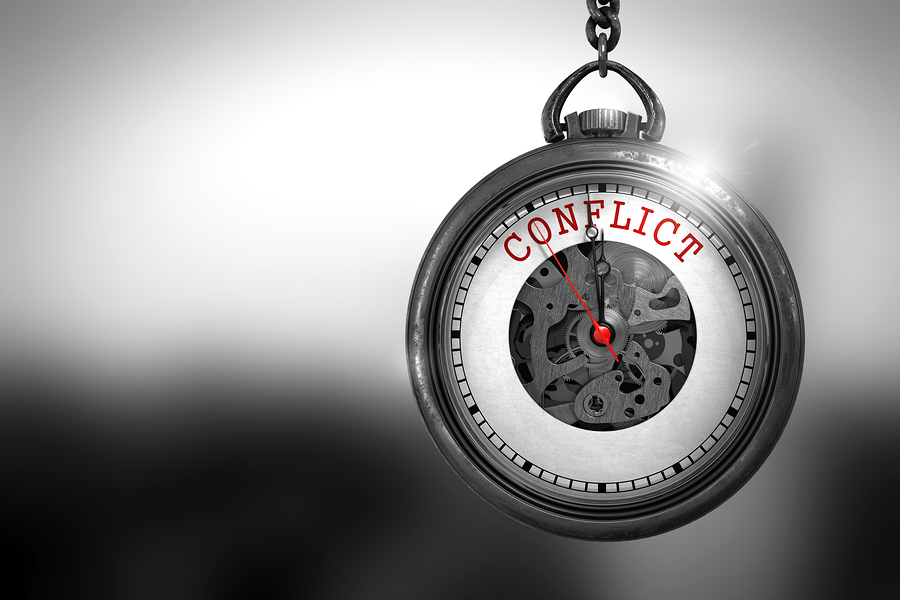Whether in the news, at home, or within our workplace, conflict has become quite a regular part of our vocabulary. In this article, I’ll explain how workplace conflict arises and how we can effectively shut it down.
Let’s take a look at the formal definition of conflict by Merriam-Webster:
Conflict [noun]
- A struggle for power, property, etc.
- A strong disagreement between people, groups, etc., that results in an often-angry argument
- A difference that prevents agreement: disagreement between ideas, feelings, etc.
I can think of specific situations in my life in where these definitions perfectly describe the events.
There have even been times when I have actually been a contributor to those moments of conflict…after all, it takes two to tango…
I am not proud of that fact, but now, as a Fully-Trained Adult (FTA), I look back on those moments and I see that I was unable (or unwilling) to see things from the other person’s perspective—a problem that fuels conflict and can lead to bullying and harassment.
In situations of workplace conflict, the cause is often interpersonal friction, borne out of annoyance or frustration as a result of different views on what should be done or how things should be done. The result of conflict is a complete lack of respect in the workplace.
Sound familiar?
I’m assuming we have all experienced conflict. In fact, there are numerous studies telling us that conflict is an inevitable part of the workplace experience. Experts say conflict might actually be healthy! …Who would have thunk?
But what is important is how we choose to handle that conflict when it arises. In respectful workplaces, we want to make sure that managing conflict is not an insurmountable wall. With resilient teams who communicate well, conflict is an almost foreseeable part of sharing space with other humans.
Surveys show that half of all employees have reported some form of interpersonal conflict at work in the last year, whether it be an isolated dispute or an ongoing difficult relationship.
Such conflict is obviously more common with people we work with closely, and can’t avoid, such as our immediate managers.
Unfortunately, working under conflict will result in stress and lack of motivation. As we know, difficult working relationships with those in leadership are particularly stressful.
Self Quiz
Think back to a time when you were at odds with your immediate supervisor and answer the following:
- How excited were you to work hard following a conflict?
- How happy were you about coming to work each day?
I’m guessing your answers to both were: Not very.
What’s worse, is that a dip in motivation, productivity, or commitment level may be just the beginning. If the situation gets worse, you may even consider leaving that job entirely or asking for a transfer.
So, what exactly do these conflicts look like? Most of us would likely respond that they stem from a lack of respect as demonstrated by the other person.
Some of the factors which undermine respectful workplaces and lead to conflict:
- Differences in personality or styles of working
- Individual competence or performance
- Real or perceived levels of support or resources
- Agreeing on deliverables or setting targets
- Contract of employment/terms and conditions
- Absence or absent management
- Promotion concerns
Now that we’re thinking about our own workplace conflicts and getting upset (I apologize), how do we go about responding to them?
Most employees will respond to conflict in one of four ways:
- Informal discussion with the other person
- Formal grievance, discipline, or complaints procedure
- Discussion with member of family or friend
- Not doing anything, just letting it go
Although there is definitely a place for formal processes in organizations, my professional experience shows that by far the best way to handle conflict is to have an informal conversation with the other person.
The more formal procedures are sometimes ineffective because they encourage parties to set battle lines, fostering a zero-sum game mentality and making views more entrenched, instead of encouraging a more balanced and positive win–win outlook.
So, since informal conversations are the best route, let’s take a look at the steps to take to have an effective line of communication.
How to informally resolve a conflict at work:
- First of all, thank the other person for agreeing to discuss the situation
- Speak calmly
- Explain in detail what the other person has done that offended you and provide specific examples of the behaviour
- Stay focused on how the issue is impacting you in the workplace
- Tell the person to stop doing what they are doing and state your commitment to being part of the resolution
- If the other person apologizes, accept the apology and thank them
- Confirm the agreed-upon resolution and clarify what each of you will do to implement the resolution
- Finally, make certain that you thank the other person for their willingness to work on the change
But of course, we may sometimes be on the receiving end of such a conversation (nobody’s perfect), so here are some things to keep in mind.
How to respond to a request for conflict resolution:
- Have the conversation
- Act respectfully
- Clarify critical information if you do not understand something
- Do not argue thoughts, feelings, and perceptions
- Respect reasonable requests
- Give the other person credit for having this conversation— it’s not easy
Many of my clients who are progressive and proactive-thinking organizations use variations on these steps in their Respectful Workplace Policies.
If you’re reading this as a supervisor or manager, consider making a shift in your expectations and practices when it comes to resolving conflict. The approaches for alternative and informal dispute resolution should make up part of the required skill set of any well-rounded leader.
Let’s work together to enhance the ability of our workforces to engage in informal conversations to resolve or contain low-level conflict before it gets out of hand.
As a Fully-Trained Adult (FTA), I implore you…







Leave A Comment